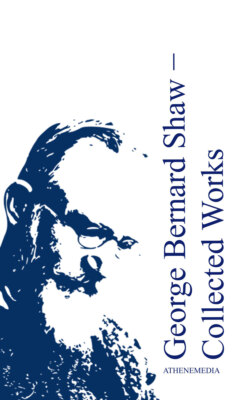Читать книгу Collected Works - George Bernard Shaw, Bernard Shaw - Страница 92
На сайте Литреса книга снята с продажи.
THE RELIGIOUS ART OF THE TWENTIETH CENTURY
ОглавлениеCreative Evolution is already a religion, and is indeed now unmistakeably the religion of the twentieth century, newly arisen from the ashes of pseudo-Christianity, of mere scepticism, and of the soulless affirmations and blind negations of the Mechanists and Neo-Darwinians. But it cannot become a popular religion until it has its legends, its parables, its miracles. And when I say popular I do not mean apprehensible by villagers only. I mean apprehensible by Cabinet Ministers as well. It is unreasonable to look to the professional politician and administrator for light and leading in religion. He is neither a philosopher nor a prophet: if he were, he would be philosophizing and prophesying, and not neglecting both for the drudgery of practical government. Socrates and Coleridge did not remain soldiers, nor could John Stuart Mill remain the representative of Westminster in the House of Commons even when he was willing. The Westminster electors admired Mill for telling them that much of the difficulty of dealing with them arose from their being inveterate liars. But they would not vote a second time for the man who was not afraid to break the crust of mendacity on which they were all dancing; for it seemed to them that there was a volcanic abyss beneath, not having his philosophic conviction that the truth is the solidest standing ground in the end. Your front bench man will always be an exploiter of the popular religion or irreligion. Not being an expert, he must take it as he finds it; and before he can take it, he must have been told stories about it in his childhood and had before him all his life an elaborate iconography of it produced by writers, painters, sculptors, temple architects, and artists of all the higher sorts. Even if, as sometimes happens, he is a bit of an amateur in metaphysics as well as a professional politician, he must still govern according to the popular iconography, and not according to his own personal interpretations if these happen to be heterodox.
It will be seen then that the revival of religion on a scientific basis does not mean the death of art, but a glorious rebirth of it. Indeed art has never been great when it was not providing an iconography for a live religion. And it has never been quite contemptible except when imitating the iconography after the religion had become a superstition. Italian painting from Giotto to Carpaccio is all religious painting; and it moves us deeply and has real greatness. Compare with it the attempts of our painters a century ago to achieve the effects of the old masters by imitation when they should have been illustrating a faith of their own. Contemplate, if you can bear it, the dull daubs of Hilton and Haydon, who knew so much more about drawing and scumbling and glazing and perspective and anatomy and 'marvellous foreshortening' than Giotto, the latchet of whose shoe they were nevertheless not worthy to unloose. Compare Mozart's Magic Flute, Beethoven's Ninth Symphony, Wagner's Ring, all of them reachings-forward to the new Vitalist art, with the dreary pseudo-sacred oratorios and cantatas which were produced for no better reason than that Handel had formerly made splendid thunder in that way, and with the stale confectionery, mostly too would-be pious to be even cheerfully toothsome, of Spohr and Mendelssohn, Stainer and Parry, which spread indigestion at our musical festivals until I publicly told Parry the bludgeoning truth about his Job and woke him to conviction of sin. Compare Flaxman and Thorwaldsen and Gibson with Phidias and Praxiteles, Stevens with Michael Angelo, Bouguereau's Virgin with Cimabue's, or the best operatic Christs of Scheffer and Müller with the worst Christs that the worst painters could paint before the end of the fifteenth century, and you must feel that until we have a great religious movement we cannot hope for a great artistic one. The disillusioned Raphael could paint a mother and child, but not a queen of Heaven as much less skilful men had done in the days of his great-grandfather; yet he could reach forward to the twentieth century and paint a Transfiguration of the Son of Man as they could not. Also, please note, he could decorate a house of pleasure for a cardinal very beautifully with voluptuous pictures of Cupid and Psyche; for this simple sort of Vitalism is always with us, and, like portrait painting, keeps the artist supplied with subject-matter in the intervals between the ages of faith; so that your sceptical Rembrandts and Velasquezs are at least not compelled to paint shop fronts for want of anything else to paint in which they can really believe.
